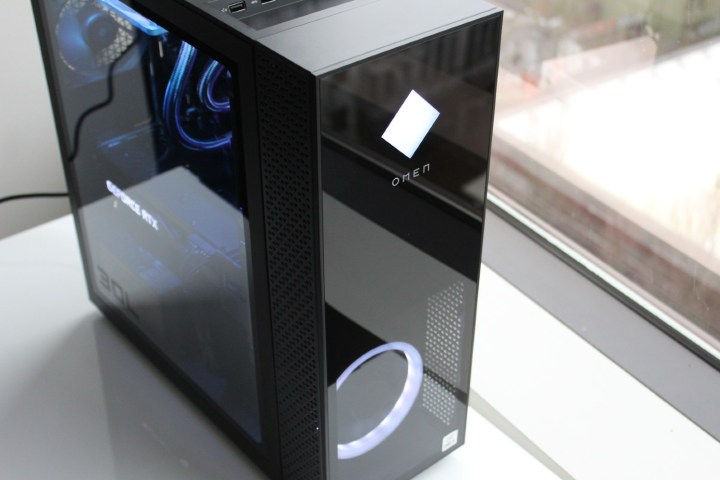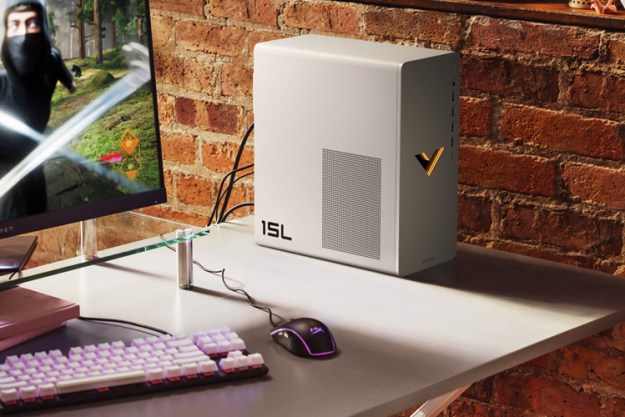
Desktop PCs come in two flavors. You’ve got prebuilt machines and DIY systems that people build themselves. We review both, whether it’s a fully-configured PC from a company like Dell or HP or the individual components that power the PC you built yourself.
But here, we focus on the first case — prebuilt systems that you buy right off the shelf. These range from simple home office computers to maxed-out gaming PCs that glow in all the right places.
Reviewing a desktop is a unique process because there are concerns relevant to them that aren’t relevant to devices like laptops, tablets or smartphones. Here’s how we do it.
Look and feel
A desktop computer usually is placed in a designated spot and stays there, but this does not mean build quality is irrelevant. Consumers long ago grew tired of black and tan mid-towers. Today’s desktops come in all shapes and sizes for all sorts of purposes, whether it be a mini-ITX compact PC or a behemoth gaming battlestation.
We take a careful look at the dimensions of the systems we review so that you know how the PC will fit into your office, home theater or living room. Basic functionality and build quality are key, as well. A good desktop needs to have easily accessible ports. Some products come with panels that cover their optical drives or flip-up front-facing ports. If these exist, they must have a robust feel and simple operation.
Aesthetics are particularly subjective, but we do provide some commentary on them — and a nice selection of high-quality photos. There’s nothing wrong with a little vanity. Desktops are often placed in public areas of a home, such as the living room, and they need to at least look as if they were worth the price paid. Lighting has become important for many potential buyers, so we always comment on how much RGB goodness a system does or doesn’t have — and how customizable it all is, of course.
What’s inside counts, too

There’s more to a desktop than its external appearance and features, however. Much more. Many desktops, unlike other modern electronics, are still partially or entirely user serviceable — at least, they should be. Processors can be replaced, graphics cards upgraded, and hard drives added. But this is only an advantage if a system is easy to work on.
We open up all the desktops we review and report on the guts. A spacious layout that is free of clutter from various cords is ideal. Small desktops have difficulty because not enough space available, but we like to see that the manufacturer gave at least a second of thought to making the internals clean and easy to work with. Some manufacturers use proprietary parts too, which makes servicing or upgrading a PC much more difficult. On the other side of the spectrum, boutique custom PCs from brands like Origin or Falcon NW put a lot of time into small details like cable management.
Tool-free design features and readily accessible expandability are also a boon. We prefer case panels that pop off with a latch system, hard drives that can be exchanged without hassling with screws and RAM slots that are free for an upgrade. Even small systems can make hard drive swaps a breeze — if they’re properly designed.
Not all desktops are upgradeable, of course. Something like a Mac mini or iMac are popular choices, but they provide almost no ability to expand the system or repair it yourself.
The extra mile
Most computers see success because of a combination of great hardware and reasonable pricing, but we can’t judge a PC only by the configuration we’re sent. When reviewing a desktop, we take a careful look at how the manufacturer lets you configure your PC. Are there lots of options? Are they overly expensive? These are all important to consider.
Beyond just price, aspects like software can be both a hazard and a boon, depending on how it’s implemented.
Warranties and peripherals can also be a defining trait. If all other things are equal a system with a 3-year warranty will be a better buy than one with a 1-year warranty. Manufacturers are notoriously stingy with warranty periods, so we always comment when a system offers exceptional service at no additional cost.
The test bench

Performance is obviously a concern for anyone buying a computer. We put all desktops through a number of benchmarks that provide a way to objectively gauge performance.
Our general CPU benchmarks include a video encode test using Handbrake to run a 4K video through x265 encoding, Geekbench’s single and multi-core tests, and Cinebench R23’s single and multi-core tests. These tests put the processor on maximum attack and give us an idea how a system performs in demanding applications. We’ll also test it on PCMark 10, which gives a very well-rounded look at the PC’s performance across a wide breadth of tasks and applications.
After this is completed we run CrystalDiskMark (or Blackmagic, for Macs), to test each disk drive’s sequential read/write speed.
We wrap up our suite with 3DMark’s Time Spy, Fire Strike, and Sky Diver tests, three synthetic benchmarks that offer a good window into overall graphics performance. If a system is built for gaming we also conduct real-world game tests at 1080p, 1440p, and 4K with titles like Civilization VI, Fortnite, Cyberpunk 2077, Red Dead Redemption 2, and Assassin’s Creed Valhalla. We also test the system with creative applications, such as the Pugetbench Premiere Pro benchmark.
Now, it should be said that often times, we’re already familiar with how fast a review unit’s CPU and GPU will be as we’ve often already tested them on our own test bench. But how they perform within this specific system is what we’re evaluating, which brings us to cooling.
Cooling
Desktops usually do not become as warm as other, smaller PCs, but cooling must still be considered. Some systems are quieter than others, and some offer better cooling of internal components. This is of particular concern for gaming systems, which can become extremely loud and hot during intense use.
To judge how a system is to live with we use a decibel meter and take a measurement of noise from two feet away from the front of the desktop. A reading is taken at idle, during the 7-Zip processor test, and after a ten-minute run of the Furmark graphical stress test. This provides a broad idea of how loud the desktop is under various conditions.
Putting the pieces together

Desktops are complex products that consist of numerous components. This makes the verdict important, but also difficult to reach. There’s no simple 1+1 formula that can be applied. Every component has an effect on every other.
With that said, we usually reach our verdict through the lens of the desktop’s intended purpose. A budget PC meant for basic computing will not severely penalized if it doesn’t ace our benchmarks, but a high-end workstation with the same failing would be nearly worthless. We try to put ourselves in the shoes of the person who is likely to be buying the system and ask if the computer does what is expected of it — and more.
Pricing and competition are obvious concerns, as well. Our verdicts usually include some market research into the price of similar desktops and their value compared to the system being reviewed. A low price can forgive some — but not all — shortcomings.
Our review process is meant to provide a broad platform on which any given desktop can be judged. We don’t expect every reader to agree with every verdict, but we do hope that you leave more informed than when you arrived.
Editors' Recommendations
- Gaming laptops vs. desktops: here’s how to decide which to buy in 2024
- 10 best desktop computers of 2024: tested and reviewed
- How hot is too hot for your CPU?
- The 6 best Linux desktop PCs in 2024
- The 6 best desktop PCs for 3D rendering in 2024


